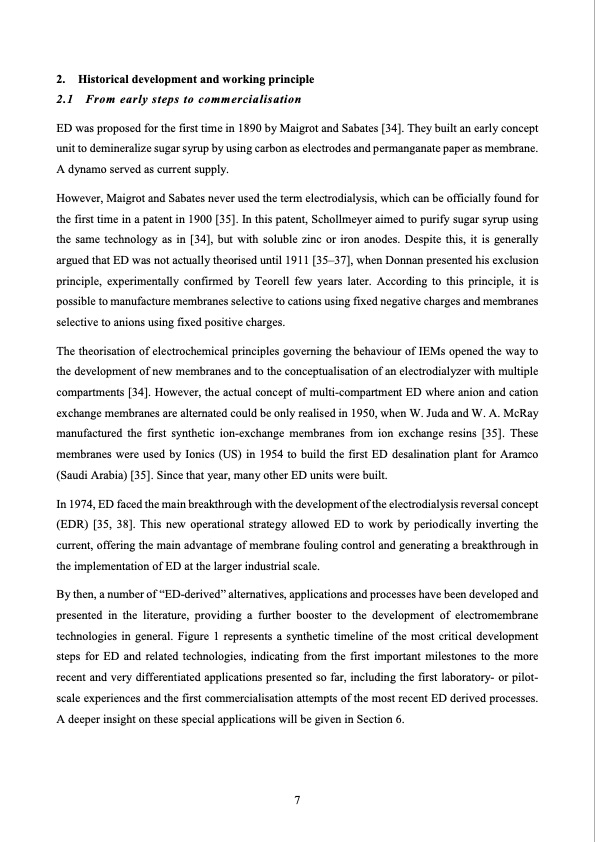
PDF Publication Title:
Text from PDF Page: 007
2. Historical development and working principle 2.1 From early steps to commercialisation ED was proposed for the first time in 1890 by Maigrot and Sabates [34]. They built an early concept unit to demineralize sugar syrup by using carbon as electrodes and permanganate paper as membrane. A dynamo served as current supply. However, Maigrot and Sabates never used the term electrodialysis, which can be officially found for the first time in a patent in 1900 [35]. In this patent, Schollmeyer aimed to purify sugar syrup using the same technology as in [34], but with soluble zinc or iron anodes. Despite this, it is generally argued that ED was not actually theorised until 1911 [35–37], when Donnan presented his exclusion principle, experimentally confirmed by Teorell few years later. According to this principle, it is possible to manufacture membranes selective to cations using fixed negative charges and membranes selective to anions using fixed positive charges. The theorisation of electrochemical principles governing the behaviour of IEMs opened the way to the development of new membranes and to the conceptualisation of an electrodialyzer with multiple compartments [34]. However, the actual concept of multi-compartment ED where anion and cation exchange membranes are alternated could be only realised in 1950, when W. Juda and W. A. McRay manufactured the first synthetic ion-exchange membranes from ion exchange resins [35]. These membranes were used by Ionics (US) in 1954 to build the first ED desalination plant for Aramco (Saudi Arabia) [35]. Since that year, many other ED units were built. In 1974, ED faced the main breakthrough with the development of the electrodialysis reversal concept (EDR) [35, 38]. This new operational strategy allowed ED to work by periodically inverting the current, offering the main advantage of membrane fouling control and generating a breakthrough in the implementation of ED at the larger industrial scale. By then, a number of “ED-derived” alternatives, applications and processes have been developed and presented in the literature, providing a further booster to the development of electromembrane technologies in general. Figure 1 represents a synthetic timeline of the most critical development steps for ED and related technologies, indicating from the first important milestones to the more recent and very differentiated applications presented so far, including the first laboratory- or pilot- scale experiences and the first commercialisation attempts of the most recent ED derived processes. A deeper insight on these special applications will be given in Section 6. 7PDF Image | Electrodialysis for water desalination

PDF Search Title:
Electrodialysis for water desalinationOriginal File Name Searched:
Review_ED-self-archived.pdfDIY PDF Search: Google It | Yahoo | Bing
NFT (Non Fungible Token): Buy our tech, design, development or system NFT and become part of our tech NFT network... More Info
IT XR Project Redstone NFT Available for Sale: NFT for high tech turbine design with one part 3D printed counter-rotating energy turbine. Be part of the future with this NFT. Can be bought and sold but only one design NFT exists. Royalties go to the developer (Infinity) to keep enhancing design and applications... More Info
Infinity Turbine IT XR Project Redstone Design: NFT for sale... NFT for high tech turbine design with one part 3D printed counter-rotating energy turbine. Includes all rights to this turbine design, including license for Fluid Handling Block I and II for the turbine assembly and housing. The NFT includes the blueprints (cad/cam), revenue streams, and all future development of the IT XR Project Redstone... More Info
Infinity Turbine ROT Radial Outflow Turbine 24 Design and Worldwide Rights: NFT for sale... NFT for the ROT 24 energy turbine. Be part of the future with this NFT. This design can be bought and sold but only one design NFT exists. You may manufacture the unit, or get the revenues from its sale from Infinity Turbine. Royalties go to the developer (Infinity) to keep enhancing design and applications... More Info
Infinity Supercritical CO2 10 Liter Extractor Design and Worldwide Rights: The Infinity Supercritical 10L CO2 extractor is for botanical oil extraction, which is rich in terpenes and can produce shelf ready full spectrum oil. With over 5 years of development, this industry leader mature extractor machine has been sold since 2015 and is part of many profitable businesses. The process can also be used for electrowinning, e-waste recycling, and lithium battery recycling, gold mining electronic wastes, precious metals. CO2 can also be used in a reverse fuel cell with nafion to make a gas-to-liquids fuel, such as methanol, ethanol and butanol or ethylene. Supercritical CO2 has also been used for treating nafion to make it more effective catalyst. This NFT is for the purchase of worldwide rights which includes the design. More Info
NFT (Non Fungible Token): Buy our tech, design, development or system NFT and become part of our tech NFT network... More Info
Infinity Turbine Products: Special for this month, any plans are $10,000 for complete Cad/Cam blueprints. License is for one build. Try before you buy a production license. May pay by Bitcoin or other Crypto. Products Page... More Info
| CONTACT TEL: 608-238-6001 Email: greg@infinityturbine.com | RSS | AMP |